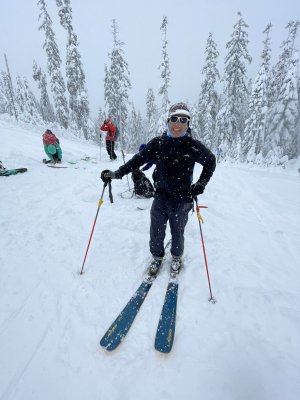I tend to run hot and sweaty.
My two cents is that you're hot and sweaty at least in part because you're wearing a lot while touring. You may be hot and sweaty by nature too, but wearing a ton of insulation in our typically mild PNW temps can't be helping. I would try ditching the First Light on the uphills and see how that feels. Pack it if you're worried about being cold, but try not wearing it while moving and see how that goes. I think you'll be surprised.
- Touring - Base layer, Traibreaker pants, First Light, Dawn Patrol. Ignitor and Uplift in pack if necessary. I need a better insulation option, as there have been a few tours where layering everything has left me cold, typically on long breaks
For perspective, I'm a very skinny guy (not a lot of natural insulation). I run probably average to slightly above average in terms of heat when moving, but get cold very easily when I stop. I can skin in just a base layer, or sometimes with a very light and breathable wind/softshell (BD Alpine Start) down to freezing and even a bit below. On days where it's sunny and no wind, I might even get into the mid to low twenties with just that. As it gets colder, a light fleece below a wind or softshell can go a long way. I've never worn a First Light, but just looking at the specs it would have to be pretty cold before I even think about skinning in that.
Then, as @Analisa said, when you stop, you need a heavier puffy jacket to throw on to keep you warm when static. Down has a lot of advantages, but a major drawback with water. Many people refuse to wear down in the PNW, although I like down myself. I figure you're going to be pretty miserable if your synthetic jacket gets wet even if it still technically maintains more insulating power. So you have to be careful either way.
In short, I suspect you're wearing too much when moving, and not enough when static.
i agree with almost everything Analisa said, and great write-up. The one thing I'm a bit skeptical on is this.
I'm not in the industry and don't have the detailed insider knowledge you do. But I'm fairly certain that's not how the physics of insulation works. Heat can be retained or lost, regardless of whether air, water, or whatever can move through it, via the process of conduction. For example, metals are shit insulators because heat is conducted through them easily, despite the surface being completely impermeable. Furthermore, if the shell was trapping body heat so effectively that it couldn't reach the down jacket, you wouldn't need the down jacket to start with and the shell would provide all the insulation you need. But that's not really how insulation works. You're trying to spread the temperature gradient over a thicker, non-heat-conductive medium so that less conductive heat loss occurs, while also halting convective heat loss (basically warm air currents moving away from you). The shell really only does the latter (okay a bit of the former too because it traps a layer of air between you and it, but not as much as a puffy does), while the puffy should do some of both. As a sanity check on what I'm saying, the entire concept of a belay puffy would be pretty much invalidated if what you describe is correct.not to belabor the point, but one time I set up camp in a freezing, damp wind, and I jumped in the tent and just threw my puffy on on top of my shell. I wasn't warming up, and my friend was finally like "take your shell off, the puffy can't capture any body heat if it can't get past the membrane." And sure enough, I lost a layer yet got warmer.


 . There are many reviews and tests by reputable sources.
. There are many reviews and tests by reputable sources.
